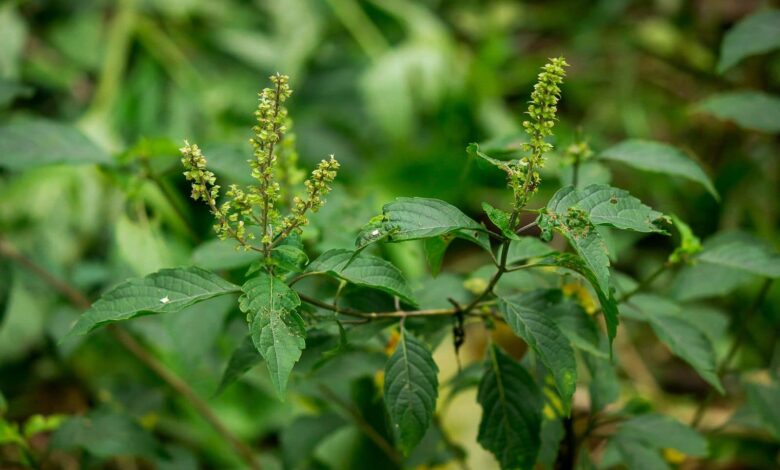Rabo de Gato: medicinal plant for digestive, skin and respiratory ailments

If you like to take care of yourself in a natural way and you want to know about the properties and medicinal uses of plants, in this article we are going to discover what cat’s tail is good for, a very interesting plant that you cannot miss without knowing.
What is the Rabo de Gato?
It is a shrub also known by other names such as terral grass, zahareña or piles grass and with a scientific name Sideritis tragoriganum Lag .
This woody perennial plant has straight stems, from which the branches emerge and from these the finite leaves and small yellow flowers that are grouped vertically along the stem. It can reach a height of 30 cm. The flowering tops are the part of the plant that is used for medicinal purposes.
The cat’s tail belongs to the botanical family of the Labiadas or Lamiáceas like other plants such as Oregano , Thyme , Mint and Rosemary . The zahareña grows wild in sunny and dry areas with stony soils.
The genus Sideritis comprises approximately 150 species distributed along the European, African and part of the Asian Mediterranean slopes, extending from the Canary Islands and Madeira to the Caucasus.
Within this genus, the species Sideritis angustifolia , Sideritis clandestina , Sideritis hyssopifolia , Sideritis incana , Sideritis raeseri , Sideritis scardica , Sideritis syriaca and Sideritis tragoriganum, among others, stand out. From the botanical point of view, this genus presents difficulties in its classification due to the tendency towards hybridization among its numerous species.
Medicinal action of the cat’s tail
This plant has in its composition flavonoids (including sideritid flavone), triterpenic steroids, essential oil, tannins, saponosides, triterpenes and lactones.
These components give the cat’s tail a diuretic, antiseptic, digestive, anti-inflammatory, healing, antibacterial, spasmolytic, antiulcer, antifungal action.
The infusion, prepared from the aerial parts of the plant, is traditionally used against gastrointestinal disorders such as stomach pain, indigestion and flatulence; also to treat the symptoms of the common cold including fever, flu, sore throat and bronchitis, as well as a tonic and diuretic.
Sideritis species have historically been used in the Mediterranean basin and Balkan countries as teas for food, flavoring agents, and in popular medicine as anti-inflammatory, antitussive, antiulcerative, antimicrobial, vulvar, antioxidant, antispasmodic, anticonvulsant, analgesic and carminative agents. Another popular use is external, the infusion applied in the form of compresses.
Recent studies demonstrate these activities and support both their traditional use and possible new therapeutic applications.
Uses and Properties of the Cat’s Tail
This plant has very interesting therapeutic applications, such as:
Applied externally, it improves conjunctivitis (inflammation of the conjunctiva) and blepharitis (inflammation of the eyelids).
It is used in cases of otitis (inflammation of the ear).
Sideritis species prepared as tea infusions are popularly known to improve memory function and cognitive ability.
The neuroprotective activity has been scientifically demonstrated, against oxidative stress
Combat episodes of meteorism (bloating due to gases).
It is an ally for people who suffer from gastritis.
It can be a useful natural remedy in cases of irritable bowel syndrome.
Relieves episodes of enterocolitis or inflammation of the digestive tract.
It improves the cases of gastroduodenal ulcer.
Reduces gastrointestinal spasms.
Applied locally, it mitigates osteoarticular inflammation and bruises.
Combat cases of cystitis.
Zahareña is a very useful plant for respiratory tract infections.
It can relieve cold and flu symptoms.
It is used for bronchitis, laryngitis and pharyngitis.
It alleviates the symptoms of sinusitis.
It is beneficial to regenerate the skin in cases of wounds, eczema and burns.
It fights fungal infections of the skin ( Dermatomycosis ).
How to use the Cat’s Tail
It can be used internally and externally.
- For internal use it is prepared mainly in infusion. Put a teaspoon of the plant (between 2 and 4 grams) for each cup, add boiling water, cover and let it rest for 10 minutes. You can take up to three cups throughout the day. Do not exceed 12 grams per day.
We can also find extracts and tinctures of cat’s tail. They would be used as indicated by the manufacturer. It can also be used in poultices and to make eye baths.
- For external use , the infusion is prepared and applied to the area to be treated once it is at room temperature.
Contraindications of the cat’s tail
It should not be consumed during pregnancy or latency.
Its use in children under 18 years of age is not recommended.
People with digestive problems should consult with their doctor before taking this plant.
If after a week of taking zahareña you notice that the symptoms get worse, you should stop taking it.
If you are under drug treatment, check with your doctor and / or pharmacist if it is possible to take this plant in your case, since medicinal plants can interact with drugs, enhancing or blocking their action.
This is general information and is not a substitute for professional medical advice. To find out if this plant can be useful in your particular case, consult a health professional who can study your medical history and can guide you on a treatment specifying dose and duration to adapt it to your specific needs.
Consulted bibliography
https://www.ncbi.nlm.nih.gov/pubmed/16491449
http://floragon.ipe.csic.es/ficha.php?genero=Sideritis&especie=tragoriganum&subespecie=tragoriganum
European Union herbal monograph on Sideritis scardica Griseb .; Clandestine sideritis (Bory & Chaub.) Hayek; Sideritis raeseri Boiss. & Heldr .; Sideritis syriaca L., herba
European Medicines Agency (EMA) – Committee on Herbal Medicinal Products (HMPC). European Union herbal monograph on Sideritis
https://www.ema.europa.eu/en/medicines/herbal/sideritis-herba
Botanical and pharmacological aspects of the genus Sideritis
Journal of Fitoterapia 2009; 9 (2): 133-145.
https://www.fitoterapia.net/buscador_avanzado/revistas.html?accion=busqueda&existe_cond=no&texto1=Rabo+de+gato&campo1=&condicion=&texto2=&campo2=&condicion2=&texto3=&campo3=&condicion3=&hasta4des&campo=
Anti-inflammatory activity of 5-O-demethylnobiletin, a polymethoxyflavone isolated from Sideritis tragoriganum.
Med Plant. 2006 Feb; 72 (2): 136-42.
https://www.ncbi.nlm.nih.gov/pubmed/16491449
Sideritis spp .: Uses, chemical composition and pharmacological activities — A review
Journal of Ethnopharmacology, Volume 135, Issue 2, May 2011, 209-225
https://www.sciencedirect.com/science/article/pii/S0378874111001498
Nrf2-dependent neuroprotective activity of diterpenoids isolated from Sideritis spp
Journal of Ethnopharmacology, Volume 147, Issue 3, June 2013, 645-652
Study of the neuroprotective activity of isolated diterpenes of the genus Sideritis
Annals of the Royal National Academy of Pharmacy, Vol. 80, No. 2 (2014)
http://anales.ranf.com/2014/vol2/09_1477.htm
Traditional uses, chemical composition and biological activities of Sideritis raeseri Boiss. & Heldr.
Journal of the Science of Food and Agriculture , Volume 97, Issue 2, January 2017
https://onlinelibrary.wiley.com/doi/abs/10.1002/jsfa.7867



![Photo of Caring for Indoor Flowering Plants: [Humidity, Pruning and Problems]](https://www.complete-gardening.com/wp-content/uploads/2022/08/caring-for-indoor-flowering-plants-humidity-pruning-and-problems-390x220.png)
![Photo of Change Soil pH: [Adjust, Change, Raise or Lower it]](https://www.complete-gardening.com/wp-content/uploads/2022/08/change-soil-ph-adjust-change-raise-or-lower-it-390x220.jpg)